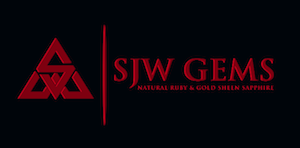I don’t know about you, but I love rubies. There is nothing like the flash from a ruby in warm light. Well cut natural rubies have, I think, the best light enhancing and return characteristics of any gemstone. I have seen several ‘pigeon blood’ rubies, selling for over $15,000 per carat, and they were so beautiful that if I had had the cash on hand to buy them, I would have.
But we have a problem in the ruby market. About five years ago, ‘neuvo riche’ Chinese were buying gemstones like their was no tomorrow. With a preference for red gemstones, with a preference for ruby. No problem with that, but demand far outstriped supply, and predictably, a lot of manufactured ruby started to enter the market.
No one who can afford it wants manufactured ruby when natural ruby is available. But it was cheap, and I believe very few vendors tried to pass it off as natural ruby. This is an example of manufactured ruby:

It looks pretty, very clear, and not at all expensive.
However, the problem that developed was mines were opened that produced very low grade ruby, normally not even considered for gemstone use. The rough from these mines was then put in a bath of acid for a week or so, dissolving out all of the iron and other impurities. What was left was technically ruby, but looked like a pinkish chalky substance. This would then be placed in a furnace and packed with glass beads at high temperature (2,200 celsius), perhaps with some chromium to improve the colour, for 100 hours.
The intense heat fuses the glass to the chalky ruby and produces a clear, solid looking stone, somewhat similar to the rough, but with much cleaner optical properties. This is known as ‘glass filled ruby’. And it is still, technically, natural ruby.
Heat treatment for corundum is nothing unusual. It has been done for many hundreds of years and is an accepted treatment to improve colour. When done properly, the treatment is permanent and will generally increase the value of the gem. But intense heat treament (over 1,600 celsius) will cause structural problems, and though the stone will look good initially, it will become degraded and lose value.
Glass filled ruby is perhaps the worst of all possible heat treatment. For a few months it looks great, really clear, and with the right additives during heating can even approach the excellent colour properties of pigeon blood ruby.
As time goes on however, stresses caused by heating cause the glass to develop microfractures. As well, glass is still only glass, will scratch and crack with everyday wear in jewelry. Typically within a year the gem is not looking good at all. And this can never be fixed. Reheating will just destroy it and the flaws are embedded throughout the stone.
Because of demand, glass filled ruby flooded the market, being sold as ‘Natural Ruby’ – which is was, technically. More savvy buyers might ask if it was heat treated, to which the answer would be ‘yes’ – there being nothing wrong with heat treating in the normal case.
Perhaps the biggest issue is that when is is new, glass filled ruby is very hard to tell from normal heat treated ruby. Inspection through a 10x loupe or even gemologist microscope generally won’t reveal it, and it tests just like normal ruby with a refractometer. It requires a lengthy several hundred dollar lab analysis to identify it correctly in the early stage. (later on it becomes obvious, but by then it is usually too late).
What the buyer thinks is that they are getting a bargain. What looks like $5,000 per carat ruby being offered for only $2,000.
Here is a ruby I bought two years ago. It looked great when I bought it, and a bargain at only $200, I thought.

It is easy to see just with the eye that there are cloudy areas in this gem. This is what happens with glass filled ruby, the glass develops fractures and destroys the appeal of the gem.

At higher magnification even more problems can be seen. The white areas are shattered glass within the stone. Surface inclusions have also become apparent. None of these flaws were observable when I first bought this ruby.
And so that is the problem. The market was flooded with this utter crap glass filled ruby, and there is still a lot of it around today. Fortunately today though, it is fairly easy to spot – you can see many vendors on Silom Road offloading it for 50 Baht ($1.50) a carat or less. The signs still say ‘natural ruby’ but the price makes it obvious it is glass filled. Incidentally, it is not even worth 50 baht, you are better buying just coloured glass for a few cents, which at least will be more durable.
Nevertheless, ruby remains a truly beautiful gemstone, but understandable doubt has been sown in the minds of buyers due to the glass filling practice.
So if you want to buy ruby (and you should, because it is beautiful), look for ‘Natural UNHEATED‘. Whether glass filled or not, a loupe is usually sufficient to determine if a gem has been heated. If it is unheated, then there is simply no way it can be glass filled.
